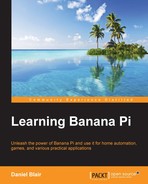This book covers the topics of the Banana Pi and single-board computing. Single-board computing generally refers to the computers that reside entirely on one chip. The computer that we are dealing with is the Banana Pi, which is based on the Raspberry Pi, the open source computer.
Single-board computing has become extremely popular as of late for its use in prototyping, education, and gaming. This book will introduce you to all of these topics. We will go from the beginner to the intermediate level in just a few chapters.
The communities that developed these devices have come up with many cool use cases, such as tiny low power servers, media devices, and arcade machines. We will explore a few popular uses of the Banana Pi, which will show you just how versatile your little computer is.
Also, there are a lot of different operating systems that are available for the Banana Pi. We will explore the set up and use of two of the most popular operating systems, Android and Linux. You will be an intermediate user by the time we are done here, which will set us up to explore complex projects, such as robotics, further down the road.
Chapter 1, An Overview of the Banana Pi, gives an introduction to the Banana Pi board. It also covers the basic components of the Banana Pi.
Chapter 2, Preparing the SD Card, covers one of the most important steps to owning your first Banana Pi. We will learn how to prepare the SD card on multiple operating systems.
Chapter 3, Linux and the Command Line, talks about the Linux operating system and some useful commands. This is important when you are using the Banana Pi because almost all of the operating systems for the Banana Pi are based on Linux.
Chapter 4, Programming on the Pi, explores the different programming languages that are supported by the Banana Pi. This will introduce the user to some code and different use cases.
Chapter 5, Hardware for Your Pi, explores some of the hardware that you can use with the Banana Pi. We will explore electrical components such as the LED and capacitor.
Chapter 6, Interacting with Sensors, deals with sensors, which are very useful in circuits. We will have a look at a few different sensors and how they can be used.
Chapter 7, Building an Internet Radio, is built upon the discussions from the previous chapters and shows you how to construct a media device. The Internet radio will be explored in a couple of ways, which will allow for it to be used more easily.
Chapter 8, Building a Home Server, takes a look at how you can build a low-power, low-cost Banana Pi home server. We will delve into the Google Apps replacements and shared calendars. All of this will be powered by your own hardware.
Chapter 9, Gaming on Your Pi, is the most fun chapter of this book. We will explore video games on the Banana Pi. We will look at building a retro game computer and explore game streaming on Android.
